Newspapers 2.0: How Web 2.0 is The Sun?
Over the last two weeks I have been looking at some of the major British newspaper websites, and examining the extent to which they have incorporated so-called "Web 2.0" technologies. Today I want to look at the last of the newspapers I am surveying - The Sun.
RSS feeds
The Sun's most recent redesign placed a prominent RSS icon with the slogan "News to you" in the masthead navigation on every page of the site.
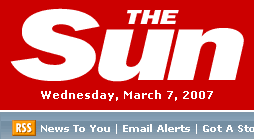
This link takes the user through to The Sun's RSS help page, which lists 21 feeds available on the site.
There does seem to be some confusion on the page though between what is an RSS content feed and what is a podcast feed - since over half of the RSS feeds listed are actually for podcasts rather than text content. And confusingly, one, the surely now defunct "Ashes Highlights" podcast, is listed twice. [1]
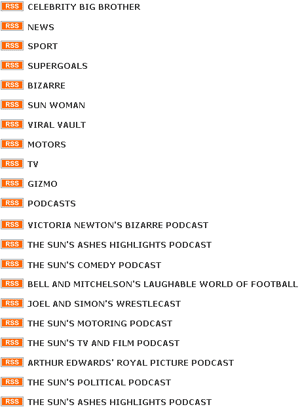
The Sun's RSS help page only mentions feed reading software - it doesn't list any online RSS aggregators at all. The feeds themselves come equipped with a stylesheet, and like The Mirror's RSS offering, The Sun's content is served via Mediafed.

The newspaper doesn't offer any buttons or widgets to help people subscribe to RSS - although it does use a graphic button on the RSS page to promote the possibility of syndicating content from The Sun via RSS.

The service is provided by a partnership between Feedzilla and The Sun, and allows users to place widgets on their sites featuring the content from The Sun's feeds.

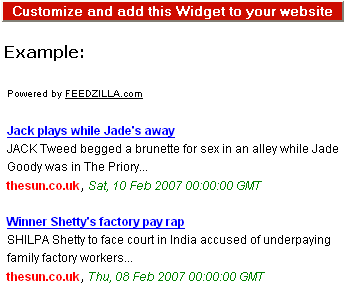
This is the most aggressive marketing for syndicating content I have noted on any of the sites I have reviewed.
Incorporating Reader Comments
The Sun includes reader comments directly on their story pages - with a prominent call to action for users to comment on a story appearing under the headline.

Comments appear under the story, and include an avatar for the user if they have submitted one to the MY Sun service.
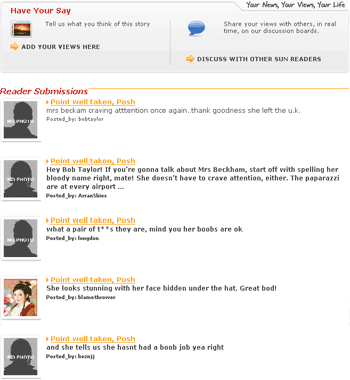
The MY Sun service from the newspaper is probably the most advance personalisation and online user-generated comment system of any currently offered by a British newspaper (although The Telegraph have recently announced ambitious plans in this arena, and it appears The Mirror have some more developments forthcoming).
MY Sun brings together a custom news panel based on the user's preferences, alongside discussion forums, and the ability for users to make their own blog style entries in their personal space.

The Sun also promotes their latest MY Sun user discussions with a panel on the homepage.

Social Bookmarking Links
The Sun's online site appears to have no social bookmarking links in any section - content, blogs or MY Sun.
Blogging
The Sun's blogs are mentioned in the left-hand navigation of the site, and clicking the link reveals a sub-menu of 7 blogs.
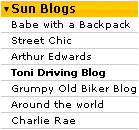
The Sun's blog homepage lists a couple of additional blogs, and there also other areas of the site called 'blogs' which are not listed in either place.

The content of the blogs is of variable quality. The Dater X blog, for example, consists of just three archive posts that are thinly veiled advertorials for The Sun's online dating service.
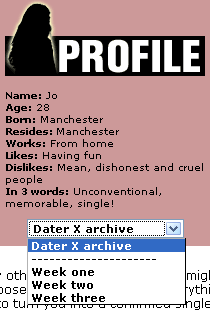
Toni Perry's "I Believe I Can Drive" blog looked like it had much more content on it - but it hasn't been updated since November last year. Vic Mahew's motor bike blog is more frequently updated, and The Sun has also published a couple of travel related blogs with a very tight focus and timescale to them.
The blogs are very light on features though. Navigation is generally through a panel on the right-hand side of the page that shows the last few entries. There are no RSS feeds or reader comments. Notably, the lack of comments makes the blog pages on the site less interactive than a standard The Sun news article.
And for some of The Sun's blogs, the word "blog" in the title is the only thing that remotely blog-like about it. They market Trevor Kavanagh's political column as "The Blog Politicians Fear", but more accurately it could be described as the blog that doesn't look like a blog.
A quick list of 'typical' blog features that Trevor Kavanagh doesn't have includes permalinks, a timestamp, comments, categories, previous/next navigation, date-based navigation, an RSS feed and a homepage link. In fact, the only feature I can find that suggests it is a blog is that it is a series of short-ish articles written by one author - which isn't enough in my book.
Web 2.0 Verdict
The MY Sun user generated content feature is an ambitious attempt at harnessing the content production potential of The Sun's online reader base. Even if I have sniffed at it in the past for The Sun using it to solicit topless snaps of their young female readers, it is a more involved "member page" system than any other UK paper has managed so far.
The paper doesn't yet seem to be doing quite as well at getting the best of that content onto their actual story page, where The Daily Mail is leading the way. However, we shouldn't under-estimate the step-change in The Sun's website over the last couple of years. It is, in fact, barely a year since most of The Sun's online content was locked behind a subscription only firewall.
Elsewhere The Sun is not pushing forwards too much with Web 2.0 technology. Their RSS sign-posting needs improving, and the number of feeds on offer is limited. The paper is yet to experiment with social bookmarking widgets and buttons.
Next...
That is the end of my in depth reviews of eight of the UK's major national newspapers.
Next week, though, I'll be continuing my look at 'Newspapers 2.0' with some comparisons of the features available on the different sites, and by drawing some overall conclusions from the reviews.
[1] Not the first time I've noticed The Sun getting confused with lists - The Sun's sexiest barmaid vote goes a bit tits up [Return to article]
Can a newspaper every be truly 2.0? By its very nature, it collates, and then editorialises the news, allocating reportage according to its own political and marketing preferences. The only 2.0 way of collecting news is Digg itself.
Similarly, newspapers work hard to cultivate a certain image of their reader. It may not be accurate, but in many cases it is aspirational: The Sun's 'salt of the earth working man'; the Guardian's 'eco-socially minded consumer' the Express' 'British values of fair play and Diana'. When they actually open their communities to the general public, it's often more of a chimps' tea party, with different factions throwing mud at each other from across the table, destroying the careful 'broad church' branding of the paper's marketing department, and sending moderates running for the hills.
In fact, many people visit the sites of the opposing end of their political spectrum in order to explain to others why their viewpoint is the spawn of the devil itself - hitherto unknown (or even plausible) in print media, should these individuals be considered as much a part of the readership, and thus marketing strategies, as those toeing the 'party line?' And if so, does this mean that the news stories given prominence should not necessarily be the ones considered important to the readership, but ones most likely to foster debate and violent reaction?